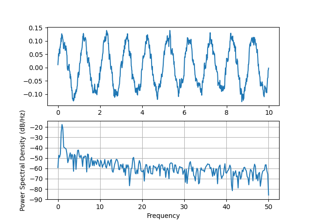matplotlib.axes.Axes.psd#
- Axes.psd(x, NFFT=None, Fs=None, Fc=None, detrend=None, window=None, noverlap=None, pad_to=None, sides=None, scale_by_freq=None, return_line=None, *, data=None, **kwargs)[source]#
Plot the power spectral density.
The power spectral density \(P_{xx}\) by Welch's average periodogram method. The vector x is divided into NFFT length segments. Each segment is detrended by function detrend and windowed by function window. noverlap gives the length of the overlap between segments. The \(|\mathrm{fft}(i)|^2\) of each segment \(i\) are averaged to compute \(P_{xx}\), with a scaling to correct for power loss due to windowing.
If len(x) < NFFT, it will be zero padded to NFFT.
- Parameters:
- x1-D array or sequence
Array or sequence containing the data
- Fsfloat, default: 2
The sampling frequency (samples per time unit). It is used to calculate the Fourier frequencies, freqs, in cycles per time unit.
- windowcallable or ndarray, default:
window_hanning A function or a vector of length NFFT. To create window vectors see
window_hanning,window_none,numpy.blackman,numpy.hamming,numpy.bartlett,scipy.signal,scipy.signal.get_window, etc. If a function is passed as the argument, it must take a data segment as an argument and return the windowed version of the segment.- sides{'default', 'onesided', 'twosided'}, optional
Which sides of the spectrum to return. 'default' is one-sided for real data and two-sided for complex data. 'onesided' forces the return of a one-sided spectrum, while 'twosided' forces two-sided.
- pad_toint, optional
The number of points to which the data segment is padded when performing the FFT. This can be different from NFFT, which specifies the number of data points used. While not increasing the actual resolution of the spectrum (the minimum distance between resolvable peaks), this can give more points in the plot, allowing for more detail. This corresponds to the n parameter in the call to
fft. The default is None, which sets pad_to equal to NFFT- NFFTint, default: 256
The number of data points used in each block for the FFT. A power 2 is most efficient. This should NOT be used to get zero padding, or the scaling of the result will be incorrect; use pad_to for this instead.
- detrend{'none', 'mean', 'linear'} or callable, default: 'none'
The function applied to each segment before fft-ing, designed to remove the mean or linear trend. Unlike in MATLAB, where the detrend parameter is a vector, in Matplotlib it is a function. The
mlabmodule definesdetrend_none,detrend_mean, anddetrend_linear, but you can use a custom function as well. You can also use a string to choose one of the functions: 'none' callsdetrend_none. 'mean' callsdetrend_mean. 'linear' callsdetrend_linear.- scale_by_freqbool, default: True
Whether the resulting density values should be scaled by the scaling frequency, which gives density in units of 1/Hz. This allows for integration over the returned frequency values. The default is True for MATLAB compatibility.
- noverlapint, default: 0 (no overlap)
The number of points of overlap between segments.
- Fcint, default: 0
The center frequency of x, which offsets the x extents of the plot to reflect the frequency range used when a signal is acquired and then filtered and downsampled to baseband.
- return_linebool, default: False
Whether to include the line object plotted in the returned values.
- Returns:
- Pxx1-D array
The values for the power spectrum \(P_{xx}\) before scaling (real valued).
- freqs1-D array
The frequencies corresponding to the elements in Pxx.
- line
Line2D The line created by this function. Only returned if return_line is True.
- Other Parameters:
- dataindexable object, optional
If given, the following parameters also accept a string
s, which is interpreted asdata[s](unless this raises an exception):x
- **kwargs
Keyword arguments control the
Line2Dproperties:Property
Description
a filter function, which takes a (m, n, 3) float array and a dpi value, and returns a (m, n, 3) array and two offsets from the bottom left corner of the image
scalar or None
bool
antialiasedor aabool
bool
Patch or (Path, Transform) or None
coloror ccolor
CapStyleor {'butt', 'projecting', 'round'}JoinStyleor {'miter', 'round', 'bevel'}sequence of floats (on/off ink in points) or (None, None)
(2, N) array or two 1D arrays
drawstyleor ds{'default', 'steps', 'steps-pre', 'steps-mid', 'steps-post'}, default: 'default'
{'full', 'left', 'right', 'bottom', 'top', 'none'}
color or None
str
bool
object
linestyleor ls{'-', '--', '-.', ':', '', (offset, on-off-seq), ...}
linewidthor lwfloat
marker style string,
PathorMarkerStylemarkeredgecoloror meccolor
markeredgewidthor mewfloat
markerfacecoloror mfccolor
markerfacecoloraltor mfcaltcolor
markersizeor msfloat
None or int or (int, int) or slice or list[int] or float or (float, float) or list[bool]
bool
float or callable[[Artist, Event], tuple[bool, dict]]
unknown
bool
(scale: float, length: float, randomness: float)
bool or None
CapStyleor {'butt', 'projecting', 'round'}JoinStyleor {'miter', 'round', 'bevel'}unknown
str
bool
1D array
1D array
float
See also
specgramDiffers in the default overlap; in not returning the mean of the segment periodograms; in returning the times of the segments; and in plotting a colormap instead of a line.
magnitude_spectrumPlots the magnitude spectrum.
csdPlots the spectral density between two signals.
Notes
For plotting, the power is plotted as \(10\log_{10}(P_{xx})\) for decibels, though Pxx itself is returned.
References
Bendat & Piersol -- Random Data: Analysis and Measurement Procedures, John Wiley & Sons (1986)
